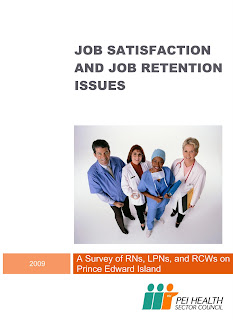For Immediate Release
June 17, 2009
The Department of Health Begins Work on a Province-wide Model of Care
CHARLOTTETOWN, PEI -- Over eighty people from across the provincial health system came together recently to form the Model of Care Design Team and to begin work on improving the ways in which health care is organized and delivered on Prince Edward Island.
“The results of the 2008 review of our health system indicate that we need to work together as an integrated health system to continue to provide quality health care for all Islanders,” said Premier Robert Ghiz. “The Model of Care Design Team is making an important contribution in achieving the Government’s vision of One Island Community, One Island Future, One Island Health System.”
Similar to other jurisdictions, Prince Edward Island’s health system faces human resource shortages, increasing demands for services and rising health care costs. The work of the Model of Care Design Team involves the creation of a “made in Prince Edward Island” solution that address these challenges.
Specifically, the Model of Care Design Team will look at clarifying the roles of Island health care providers and support staff, and improving the interactions between these roles so that all members of the health care team are empowered to work to their full potential.
“We know that our most valuable health resources are the people working within the health care system. The Model of Care Project will ensure that the effort they put forth produces optimal results across the system,” said Minister of Health, Doug Currie. “We need to find ways to operate as a team and to create opportunities to leverage the collective skills and talent of our team.”
In a display of the Government’s support for the project, Premier Ghiz, Minister Currie and Provincial Treasurer Wes Sheridan visited the team on the second day of their three-day planning session. “As a government, we recognize the importance of listening to those who work within our health care system,” said Minister Sheridan. “I was certainly impressed with the energy and enthusiasm of those involved in the Model of Care project, and have every confidence that their recommendations will enhance the way health care is delivered to all Islanders.”
Model of Care Design Team members come from across the province and represent a wide range of health care skills and perspectives, including physicians, nurses, support staff and associations.
In addition to ensuring that our health system can continue to deliver high quality care sustainably, a redesigned model of care will empower health care providers to work collaboratively to the full potential of their abilities and training. Research supports that an effective model of care can improve both the quality of care and the quality of work life for health care providers.
The Design Team will reconvene this month to continue this important work, and detailed planning will take place over the summer for the implementation of the redesigned model.
BACKGROUNDER
In November 2008, the results of the Corpus Sanchez (CSI) Health System Review were released. Hundreds of Island health care providers, public citizens and stakeholders participated in this review, contributing to the sustainability of the health system and the improved health services for all Islanders.
The Government of Prince Edward Island has endorsed the report’s general direction of One Island Health System. Extensive investigation, review and planning are now underway across the health system to determine which solutions will work best for Prince Edward Island. This is the work of the Department of Health’s Integrated Health System Project.
The Integrated Health System project will concentrate on operational improvements and service realignment. The goals are to improve health outcomes, enhance access and refocus the emphasis of the care delivery system on primary health care and services that can appropriately and safely be provided locally.
The Model of Care Project, referred to officially as the Collaborative Care Team Project, is looking into the ways in which health care providers and support staff can operate as a team. The redesigned model of care within One Island Health System will be centered on patient needs and will strive to make the best use of the system’s skills and expertise. The model will ensure that the most appropriate member of the health care team can provide the most appropriate service at the most appropriate time and place.
The Prince Edward Island Department of Health employs over 2000 health care providers, including physicians, registered nurses, licensed practical nurses, resident care workers and allied health professionals. The 2008 review of the health system reveals that the existing care delivery system is limiting the capacity of these care providers to work to the fullest extent of their abilities.
Opportunities for improvement exist in staffing models, work processes, and the use of information and supporting technology. National research and best practices show that Model of Care strategies are being used to reduce health system barriers by creating and supporting interdisciplinary, collaborative care delivery environments.







